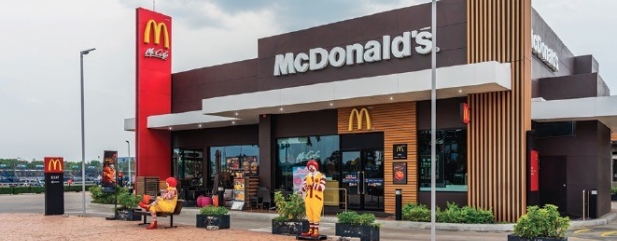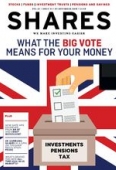Archived article
Please note that tax, investment, pension and ISA rules can change and the information and any views contained in this article may now be inaccurate.
McDonald’s investors will be ‘lovin’ it’ if its growth plans succeed

A man was walking along a busy shopping street with his six-year-old niece looking for a place to stop for lunch. They spotted a McDonald’s and immediately the little girl reeled off the meal, drink and toy she wanted to have – no menu required, no eye-catching photos to prompt a decision, she just knew.
This is a true story and a pertinent illustration of the brand power and pervasiveness of the world’s largest fast food chain. With more than 38,000 restaurants in 120 countries worldwide, some marketing experts believe the chain’s ‘Golden Arches’ are more widely recognised than the Christian cross.
Earlier this year Forbes ranked McDonald’s as the 10th most valuable corporate brand in the world, worth $43.8bn, and the fourth most prized non-technology business.
FRANCHISE POWER
McDonald’s owns and runs around 2,600 of its outlets itself. The remainder are franchises, where the company licences its operating model to franchisees in a profit share arrangement.
This means McDonald’s can maintain oversight over its brand, retain quality control on its detailed food preparation processes while driving productivity improvements. At the same time gaining meaningful economies of scale as well as providing centralised marketing and some administration.
RECENT TRADING
In October the maker of the iconic ‘Big Mac’ reported third quarter earnings per share (EPS) of $2.11 on revenues of $5.43bn. This fell modestly short of analyst estimates pitched at $2.21 EPS from $5.5bn revenue, although the company added that its global same-store sales were up 5.9% during the period, beating the 5.6% forecast.
This is the 17th consecutive quarter of positive like-for-like income.
Near-6% underlying sales progress for a mature business in a global economy showing lacklustre growth at best is no mean feat, yet investors gave the third quarter update the cold shoulder.
Its share price fell more than 5% from $209.85 to $199.27, and nudging lower still over the following days to $196.70.
This leaves the stock trading on a 2019 price-to-earnings (PE) ratio of 25.3, based on the $7.76 EPS analysts expect the company to report for the full year to 31 December.
The stock is now trading on a next 12 months PE of 23.4, about a 7% discount to its peers (Starbucks, Wendy’s, Yum! Brands etc).
VALUATION VERSUS PEERS
Measured versus its peer group McDonald’s stands on an enterprise value-to-earnings before interest, tax, depreciation and amortisation, or EV/EBITDA for short, of 17.4 versus the average of 17; a price-to-cash flow of 18.3 against 19.1; and the equivalent dividend yield is 2.6% against 1.9%.
Even at $196.70 the stock has performed strongly over the past year, rallying nearly 12.5% versus the S&P 500’s 10.9%. The stock has more than doubled the return of the S&P over two, three and five-year periods. As recently as August McDonald’s shares were trading at record highs of $221.15, for a 2019 PE of 28.5.
So while third quarter same-store growth figures were impressive, it is understandable that the headline revenue and earnings misses caused a loss of momentum given it was trading on a high rating.
TRACK RECORD
McDonald’s remains a reliable dividend grower. The company has an unbroken 42-year record for growing its annual payout to shareholders stretching back to 1976.
McDonald’s also performed strongly through the hefty sell-off in global equities a year ago, rallying around 10% in the early October to mid-December 2018 slump. During the same period the S&P lost 500-odd points, or about 17% of its value, arguably signalling the stock’s relative stability and resilience in the face of short-term market swings.
NEW LOOK STORES
If you’ve not been in to a McDonald’s for a long time you may still picture them as grotty little places with cheap plastic furniture, long queues of hungry customers being very slowly served by bored staff.
This is not really the case today. Restaurants have been refitted, brightened up and dragged into the 21st Century.
The growth strategy has positioned the business for the future with free customer wi-fi, phone charging points, self-order kiosks and curb-side pick-up through mobile app ordering.
McDonald’s has been providing home delivery in many markets for some time, via its exclusive deal with Uber Eats, and it is also testing meat-alternative products, which could bolster its social cachet with healthier-eating and ecology-mindful millennials, one of the chain’s longer-run challenges, according to critics.
McDATA DRIVE
Perhaps the most surprising and ambitious shifts McDonald’s has been making is in technology and data analytics. In September it agreed to buy Apprente, a start-up that is designing and building conversational robots that can automate voice-based ordering in multiple languages.
This should be a neat fit for McDonald’s fast food drive-thru business, which had already been testing Apprente’s technology in selected locations, creating voice-activated drive-thrus that it said will offer ‘faster, simpler and more accurate order taking’.
McDonald’s says the technology could also be used in mobile and kiosk ordering, which could help speed up the ordering process.
The Apprente deal followed the $300m purchase of online personalisation start-up Dynamic Yield earlier this year, with the goal of creating a drive-thru experience that’s customised based on factors like weather and restaurant traffic.
It has also invested in mobile customer engagement app company Plexure as part of its wider McD Tech Labs initiative, aimed at assessing new tech trends and apps, and perhaps even designing products itself.
FAST EATS THE SLOW
The end goal is to drive further growth in revenue and profit.
Challenges could come from many directions given the maturity and consumer-driven nature of the business. Rising unemployment in a slowing economy would presumably take its toll. McDonald’s remains one of the world’s largest private sector employers so any minimum wage hikes will pinch.
Competition is always fierce from the likes of Burger King and Kentucky Fried Chicken, among many others.
There are also several challenger brands on the market that could steal market share, such as Five Guys, Shake Shack and In-N-Out Burger.
And there is potential for fallout as the voices of environmental activists and anti-meat groups gets louder. McDonald’s is one of the largest buyers of beef in the world.
Yet McDonald’s has faced these challenges in the past and bounced back. It serves a need in its markets for consistent and affordable fast food. Its feats of endurance also reflect its strong financial position.
It is expected to have about $33bn of net debt on the books by the end of 2019, but is also forecast to deliver around $5.5bn of free cash flow this year.
Morningstar analysts estimate that free cash flow could average 33% of revenue over the next five years, comfortably paying dividends that could grow 10% a year over the next three years.
SHARES SAYS: McDonald’s is a solid company to buy for the long term. Use the current discounted share price rating as a good entry point. Buy at $196.70
Important information:
These articles are provided by Shares magazine which is published by AJ Bell Media, a part of AJ Bell. Shares is not written by AJ Bell.
Shares is provided for your general information and use and is not a personal recommendation to invest. It is not intended to be relied upon by you in making or not making any investment decisions. The investments referred to in these articles will not be suitable for all investors. If in doubt please seek appropriate independent financial advice.
Investors acting on the information in these articles do so at their own risk and AJ Bell Media and its staff do not accept liability for losses suffered by investors as a result of their investment decisions.

 magazine
magazine












